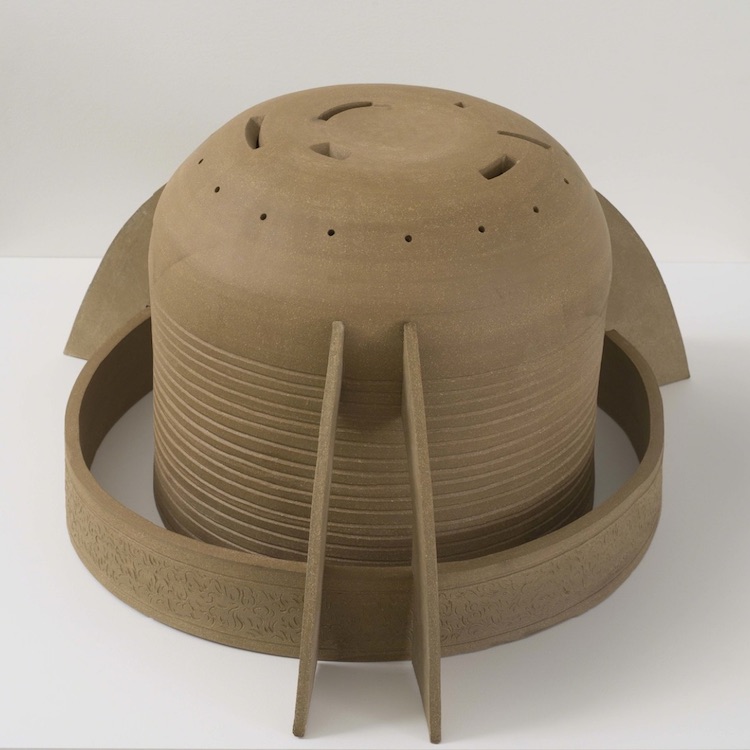PARIS — Shahpour Pouyan’s first solo ceramic exhibition We owe this considerable land to the horizon line at Galerie Nathalie Obadia (March 9 – May 6, 2017) features miniature ceramic domes drawing upon Islamic, Brutalist, and Fascist architecture which evoking consideration and reflection on the role of power structures.
Featured image: Shahpour Pouyan, High fired ceramic, 12 3/5 × 23 3/5 × 23 3/5 inches

Shahpour Pouyan, Cyclops, 2017, High fired ceramic, 17 3/10 × 10 1/5 × 10 1/5 inches. Click for larger image

Shahpour Pouyan, Cyclops (detail), 2017, High fired ceramic, 17 3/10 × 10 1/5 × 10 1/5 inches. Click for larger image
Shahpour Pouyan was born in Isfahan in 1979, a year marked by the Islamic Revolution in Iran, and grew up in Tehran in the midst of the Iran-Iraq War. He currently lives and works between New York and Tehran.
Pouyan’s practice reflects on the workings of political power, domination and possession through the language of cultural material and forms. Through his drawings, installations and sculptures, he tackles a bifurcated experience of life in Iran and in the U.S., creating a large and significant body of work that draws on a wide range of influences, from traditions of Persian art and Iranian culture to the work of visionary architects such as Etienne Louis Boullée or Claude Nicolas Ledoux.

Shahpour Pouyan, The kiss, 2017, High fired ceramic, 15 7/10 × 11 1/5 × 28 inches. Click for larger image

Shahpour Pouyan, Untitled, 2017, High fired ceramic, 12 3/5 × 15 × 15 inches. Click for larger image
In the gallery’s main space, Pouyan has installed a series of 28 ceramic domes, towers, mausoleums and monumental buildings. Each conceived and crafted by the artist, these sculptures engage a wide-ranging history of architectural forms dedicated to the display, defense, and consolidation of power. While designing the works, Pouyan drew on archetypal typologies of Islamic, Brutalist, and Fascist architecture, as well as that of 20th-century military edifices.
At the same time, the absence of any apparent door, entrance or exit in most of the works lends them a resolutely sculptural quality that unsettles their architectural quality. All works are of the same color of dark sand; each pedestal is of a different height. Infused with a sense of past menace and future foreboding, they comprise the monumental topography of an uninhabited cityscape. A subtle morphing in the shapes of these sculptures caused by the high-firing process lends this landscape the impression of a melting mirage.
In the exhibition’s foyer, Pouyan presents twelve miniatures based on a selection Persian miniatures depicting scenes from the ascension of Prophet Muhammad. By removing figures, aureoles and other unreal elements of these miniatures, he transforms them into abstract images or simple architectural scenes. These modified miniatures are subsequently printed on Japanese rice paper, and the prints are further enhanced with gilding and the addition of paint and other media.
Just as the miniatures harness the profound influence of the past and tradition to produce abstract images divested of the human form, the sculptures represent an abandoned future built on the historical fundamentals of a past and futuristic architecture.

Shahpour Pouyan, Untitled, 2017, High fired ceramic, 6 7/10 × 18 1/10 × 18 1/10 inches. Click for larger image
Another important point of reference for the artist, one that seems to haunt much of Pouyan’s oeuvre, is the Biblical tale of the Tower of Babel, which tells of humankind’s misguided attempt to build a tower to heaven. The chimeric landscape depicted by the artist appears to warn against the utopian promises of past empire and nation-building projects, framing architecture as an interpretation of unbridled human ambition.
About the Gallery: Since 1993 in Paris and 2008 in Brussels, the gallery has been a committed supporter of both international emerging and established artists such as Rina Banerjee, Michael DeLucia, Chloe Piene, Fiona Rae, Lorna Simpson, Jessica Stockholder. Fabrice Hyber, Valérie Belin, Mickalene Thomas, Brook Andrew, Joris Van de Moortel, Ricardo Brey, Edgar Arceneaux or Shahpour Pouyan joined the gallery in the past few years. The gallery pays also particular attention to the rediscovery of emblematical artists as Martin Barré, Agnès Varda, Shirley Jaffe, Sarkis or more recently Jean Dewasne. The gallery exhibits at the following Art Fairs: Art Genève, ARCO Madrid, The Armory Show, Art Basel Hong Kong, Art Brussels, Frieze New York, Art Basel, FIAC, Paris Photo, Art Basel Miami Beach.
Text (edited) by Galerie Nathalie Obadia.

Shahpour Pouyan, Dubbed, 2017, High fired ceramic, 9 2/5 × 15 × 7 9/10 inches. Click for larger image

Chess federation , 2017, High fired ceramic, nichrome, 6 3/10 × 18 9/10 × 11 4/5 inches. Click for larger image

Shahpour Pouyan, The Semitic system , 2017, High fired ceramic, 15 3/5 × 12 4/5 × 12 4/5 inches. Click for larger image
Do you love or loathe these works from the worlds of contemporary ceramic art and contemporary ceramics? Let us know in the comments.





Add your valued opinion to this post.